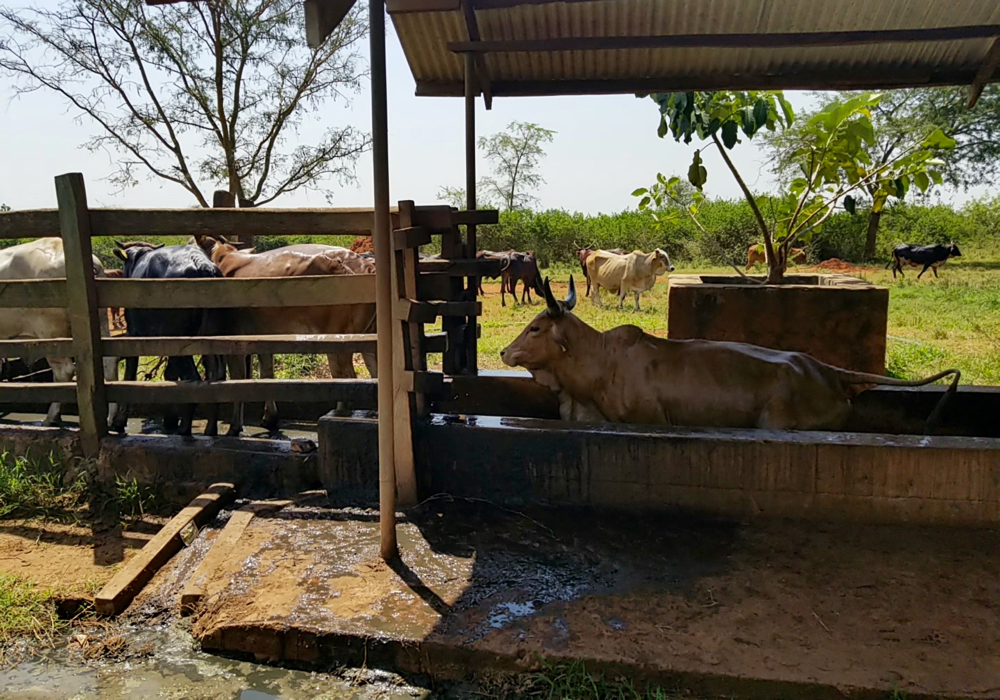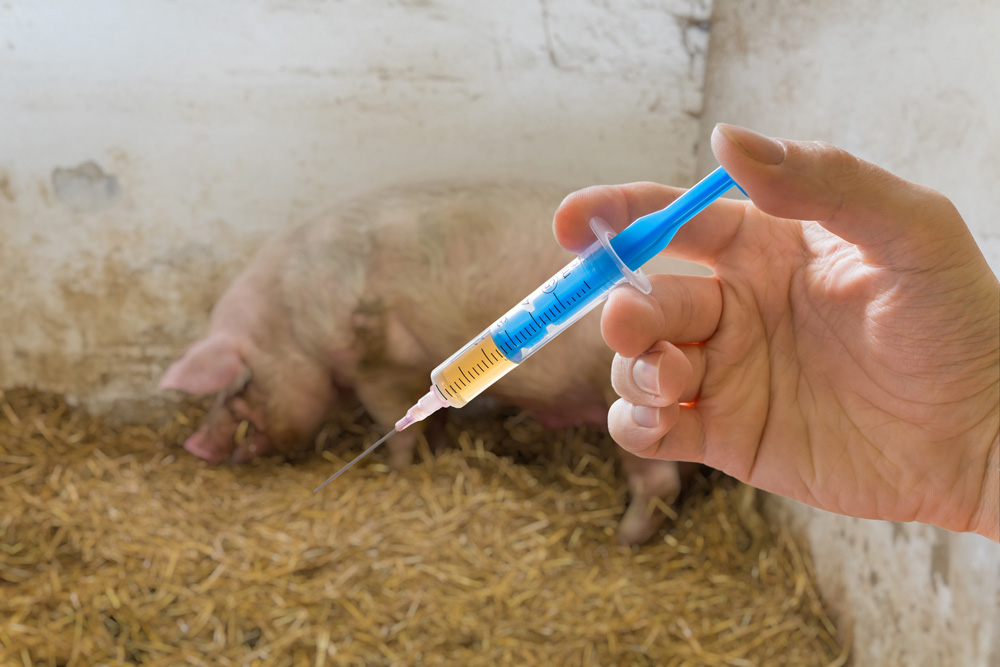Global health authorities watch with uncertainty as the human ebolavirus tragedy in West Africa unfolds. First recognized in the summer and fall of 1976, the ongoing Zaire ebolavirus outbreak is the largest since its discovery — nearly 9,300 cases and over 4,500 deaths. It continues to spread through the Democratic Republic of the Congo (or Congo, formerly Zaire, since 1997), Guinea, Sierra Leone and Liberia. The international community is on high alert.
The livestock industry also needs to keep abreast of what’s happening.
Ebola tends initially to mimic a range of other diseases, with fever, headache, and joint and muscle pain. But infection progresses to more serious symptoms after a week or so to include vomiting, diarrhea, impaired liver and kidney function, and both internal and external bleeding. Once these symptoms develop, consequences become tragic. Of the five Ebola species, the Zaire ebolavirus is usually regarded as the most deadly, with case-fatality rates as high as 90 per cent. The current outbreak has a mortality rate of about 55 per cent.
Read Also

Body condition, nutrition and vaccination for brood cows
One of the remarkable events of the past century related to ranching has been the genetic evolution of brood cows….
Ebola is a filovirus, a long, thread-like organism in the same family as Marburg virus, which was discovered a few years earlier. Both cause severe hemorrhagic fevers in humans and non-human primates.
Wake-up call?
The West African outbreak should be a wake-up call for many, including the livestock industry in North America. There’s an effect much greater than just the number of deaths. The scale of this outbreak is unprecedented. First of all, Ebola, for the first time, has invaded large urban centres. The disease is on the verge of gaining a foothold internationally as people carrying the virus travel the globe. Cases have recently been reported in the Philippines, Spain and the U.S. The bush meat trade has been clearly identified as an inciting cause of Ebola transmission and with that comes the danger of other highly infectious agents like foot and mouth disease (FMD) being dragged across the globe as a result of illegal trade in bush meat.
Nearly 40 years and many outbreaks later, there is still no specific treatment and no vaccine for Zaire ebolavirus, or any of its close viral cousins. Many ask, “Why not?”
The answer is elusive, but a key element has characterized the disease to this point in time. Ebola is a disease that strikes a few people every few years in impoverished and faraway places. Until the current outbreak, all five species of ebolavirus — Zaire was just the first to be found — had accounted for just over 9,000 reported cases around the world. And although a dreadful and merciless virus, the market for a therapy or a vaccine is very small on a world scale. Bottom line: the pharmaceutical industry’s interest in things that don’t have wide applicability is limited. In the words of Dr. Tom Frieden, director, Center of Disease Control and Prevention, “The international medical community has other, more pressing infectious diseases to worry about.”
Spurred by fears that Ebola might be turned into a bioweapon, work on this group of viruses continues in a number of academic and government labs around the world, which may pay dividends for people affected by outbreaks. For now there’s nothing ready-for-prime-time tomorrow.
In the meantime, a Canadian and an American group have combined their work to produce an antibody cocktail dubbed ZMAPP that’s very promising. There is very little of the substance and using it is fraught with huge ethical and logistic challenges. The compassionate use of a novel medication, with limited quantities available, is an ethical landmine. With agents like ZMAPP come the tough questions: whom to give it to, how to get approvals, what about informed consent for a medication that has never been tested in humans?
For the short term, controlling West Africa’s Ebola outbreak will have to rely on isolation of patients, stringent infection control precautions and vigorous tracing of contacts. The real challenge is performing these activities in a crumbling health care system that is severely stressed. At every turn, cultural beliefs create active opposition to control measures.
Threat of FMD
All financial incentives aside, poor countries serve as incubators of emerging disease with potential implications for both humans and livestock industries in both developed and underdeveloped countries.
Sierra Leone, one of the countries at Ebola’s epicentre, has over five million people. About 62 per cent of the population lives in rural areas and depends on agriculture for food and income. Seventy per cent of the population lives in absolute poverty. Life expectancy at birth is estimated at 56 years, and adult literacy level ranges from 48 per cent for men to 27 per cent for women. The population is composed of 18 different ethnic groups. The country is home for around two million cattle, sheep and goats. The bush meat trade is rampant.
Deadly jump
According to the World Health Organization (WHO), humans get Ebola through close contact with the blood, secretions, organs or other bodily fluids of infected animals (including other humans), so people who consume or otherwise handle certain bush meat are at particular risk. There is growing consensus that fruit bats are ground zero for Ebola. “Researchers think that the natural host of Ebola virus are fruit bats, and that the virus is transmitted to non-human primates and then to humans through the bush meat trade,” said Purdue University’s David Sanders, a leading expert on zoonotic diseases.
Certain cultures in Africa regularly consume bat meat. The possibility of direct transmission from fruit bats to humans has not been ruled out. Non-human primates, a favourite target of the bush meat trade, might become infected as they feast on fruit contaminated by foraging bats.
According to researchers studying the deadly virus, more animals than previously thought may carry Ebola. Chimpanzees, gorillas, fruit bats, monkeys, forest antelope and porcupines found ill or dead in the rainforest have been a source of ebolavirus.
Ebola spreads in a community through human-to-human transmission. Direct contact with blood, secretions, organs or other bodily fluids of infected people, and indirect contact with environments contaminated with such fluids are common routes of infection. The virus gains entry through broken skin or mucous membranes. The Center for Disease Control (U.S.) recently stated that aerosol transmission of ebolavirus might occur. Burial ceremonies in which mourners have direct contact with the body of the deceased person also play a role in transmission of Ebola. Men who survive the disease transmit ebolavirus in semen for up to seven weeks after recovery from illness.
The bush meat dilemma
Unable to put beef and fish on the table courts the spread of disease through animals.
Meat derived from wild animals (bush meat) is an important protein source. It is estimated between 30 and 85 per cent of daily protein intake of Africans comes from bush meat. The unsustainable nature of harvesting bush meat and the risk for human health after consumption creates a serious threat to long-term food security in many African countries.
Across sub-Saharan Africa, livestock agriculture is becoming a critical source of protein for inhabitants. Disease is its biggest enemy. The area is home for 12 of the 15 animal diseases considered by the World Organization for Animal Health (OIE) as the most contagious. The supply of meat from domestic herds is small compared to the multi-billion dollar bush meat industry.
The urban population of the Congo Basin consumes one million to five million tonnes of bush meat annually. The underground trade reaches into large cities like New York, London and Toronto. Up to 7,500 tonnes finds its way into the U.K. every year.
The communication barrier
Promoting hygienic practices to avoid contracting Ebola is a protracted and largely ineffective endeavour. Urging new norms for diet is far harder. Information about the cause and spread of disease has to be translated in simple ways for ordinary people to understand. There are those who believe that government officials invented Ebola to avoid holding elections. Health workers have been accused of introducing the virus. Witchcraft and sorcery creep into the picture at every turn. While many cases of Ebola are contracted during disposal of the dead, changing ancient customs associated with funerals is extremely hard.
In the end, it seems Ebola is here to stay. Though the present outbreak emerges in ways not previously encountered, the world holds its breath that somehow the collision between poverty, putting protein on the table and basic medical science will ultimately produce solutions to quell the tragedy. The unintended consequences of the bush meat trade, the great difficulty in managing disease in underdeveloped countries and the ability of infectious agents to get on an airplane one day and be somewhere else the next are concerns. Most important, though, are the lessons to be learned.















